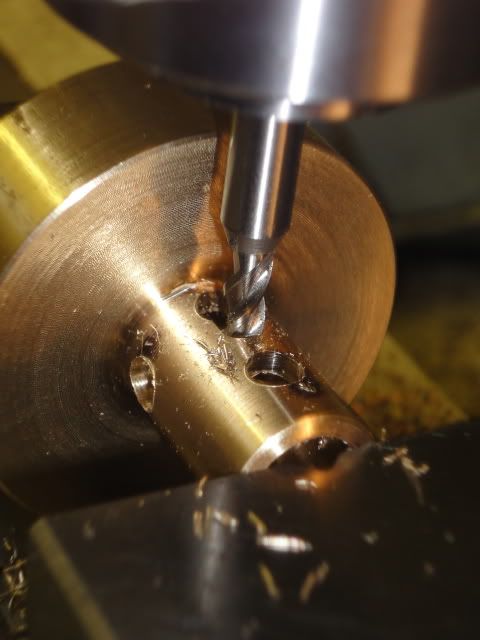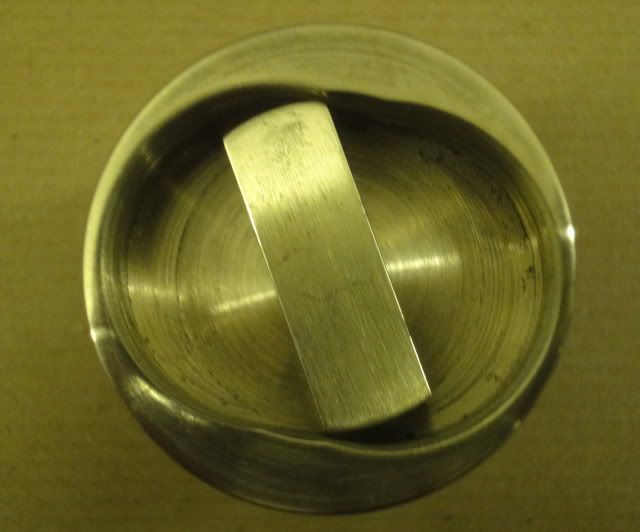You are using an out of date browser. It may not display this or other websites correctly.
You should upgrade or use an alternative browser.
You should upgrade or use an alternative browser.
Scrap bin motor
- Thread starter dvbydt
- Start date

Help Support Home Model Engine Machinist Forum:
This site may earn a commission from merchant affiliate
links, including eBay, Amazon, and others.
BaronJ
Grumpy Old Git.
Inspired by Chuck's opposed 4, I decided that I would have a play with rotary porting to see what I could learn about timing. Half way through some experimenting, this idea of a test bed motor came from nowhere!
http://www.youtube.com/watch?v=lOQOHEJTG00
Building the bits.


Assembly
http://i757.photobucket.com/albums/xx213/dvbydt/Air%20Motor/Components1.jpg[/img]

Compressed air is supplied to the copper tube. I don't have steam but I am sure it would work.

The machining took about four hours and I then had a running motor. At 10 psi it runs at 2,000 rpm and at 20 psi it makes 5,500 rpm, I did not want to try it higher!
What did I learn? Rotary ports work easily and there is no need for extreem precision, stationary leakage is no problem. Timing is not that critical. Speed is best governed by restricting the exhaust.
Has anybody got anything to add about the design of rotary ports? Then I can get on with this next project.
Ian
Very ingenious Ian ! A nice bit of machining too.
I wonder does it self start or do you have to give it a quick flick ?
Seeing Ian's original I shamelessly copied it, but without the wood base. It doesn't self start, but a quick flick will get it going. Runs at surprisingly low air pressure.
It always gets a lot of interest at the small shows I take it to.
Dave
The Emerald Isle
It always gets a lot of interest at the small shows I take it to.
Dave
The Emerald Isle
BaronJ
Grumpy Old Git.
Hi Dave,
Thankyou for your reply. I did wonder if it would self start with it having two stable positions on the rotor. I found the concept fascinating. So much so that I have started to collect a few bits together to try and make one.
Just a thought experiment having read the linked article would it scale to say six cylinders or even more and would an odd number of cylinders allow self starting.
I would love to see yours.
Thankyou for your reply. I did wonder if it would self start with it having two stable positions on the rotor. I found the concept fascinating. So much so that I have started to collect a few bits together to try and make one.
Just a thought experiment having read the linked article would it scale to say six cylinders or even more and would an odd number of cylinders allow self starting.
I would love to see yours.
With me camera out, I took a video of my 'rotor Motor'.
[ame]https://www.youtube.com/watch?v=71_vJ9dniyw[/ame]
Anyone know how you can get rid of the discolouration on the bronze? Normal polishing doesn't work.
Dave
The Emerald Isle
[ame]https://www.youtube.com/watch?v=71_vJ9dniyw[/ame]
Anyone know how you can get rid of the discolouration on the bronze? Normal polishing doesn't work.
Dave
The Emerald Isle
BaronJ
Grumpy Old Git.
Hi Dave,
Thankyou for that video. What a lovely sound. I was a little surprised at how smooth and stable the speed was. I'm most impressed. th_wav
Re the polish on bronze. I'm sorry ! I don't know. If the truth be known I don't think I could really tell the difference between brass and bronze. Though I did mention that cutting a keyway recently in a brass bush was hard work compared to the same in steel. Someone suggested that it might be bronze and not brass.
Thanks:
Thankyou for that video. What a lovely sound. I was a little surprised at how smooth and stable the speed was. I'm most impressed. th_wav
Re the polish on bronze. I'm sorry ! I don't know. If the truth be known I don't think I could really tell the difference between brass and bronze. Though I did mention that cutting a keyway recently in a brass bush was hard work compared to the same in steel. Someone suggested that it might be bronze and not brass.
Thanks:

$188.98
TM NEXDYNAMI RE41157 Water Pump Compatible With/Replacement For/John Deere 6200 7400 6300 6600 6500 6400 7220 7600 7200 RE41157
VIVID MARKET CORPORATION

$649.00
$699.00
FoxAlien Masuter Pro CNC Router Machine, Upgraded 3-Axis Engraving All-Metal Milling Machine for Wood Acrylic MDF Nylon Carving Cutting
FoxAlien Official

$39.99
$49.99
Sunnytech Low Temperature Stirling Engine Motor Steam Heat Education Model Toy Kit For mechanical skills (LT001)
stirlingtechonline

$443.98
TM NEXDYNAMI AT29618 Water Pump Compatible With/Replacement For John Deere 1020 1520 2020 300 301 400 401 440 440A 480 AT29618
VIVID MARKET CORPORATION

$426.53
DM14 Engine Build Kit, Metal Engine Build Model Great Metal Material for Engineer for Factory
Easoger Official
you can pickle brass that has been heated and discolored. the discoloration is really just copper, because the zink burned out or migrated away when heated. so all you need to do is mix some vinegar, salt, and hydrogen peroxide. it will etch the copper but leave the brass behind.
to tell the difference between brass and bronze is simple. brass is yellow and hard and makes flaky chips when machined. everything else is bronze. imo brass is just one of the bronzes (copper alloys).
if your material makes stringy chips or makes continuous chips when drilled, or is darker than bright yellow, its bronze of some kind.
to tell the difference between brass and bronze is simple. brass is yellow and hard and makes flaky chips when machined. everything else is bronze. imo brass is just one of the bronzes (copper alloys).
if your material makes stringy chips or makes continuous chips when drilled, or is darker than bright yellow, its bronze of some kind.
BaronJ
Grumpy Old Git.
to tell the difference between brass and bronze is simple. brass is yellow and hard and makes flaky chips when machined. everything else is bronze. imo brass is just one of the bronzes (copper alloys).
if your material makes stringy chips or makes continuous chips when drilled, or is darker than bright yellow, its bronze of some kind.
In that case the material I used must have been bronze ! When I turned it I needed to hone the lathe tool because it seemed not to want to cut, the tool seemed worn and blunt. The swarf was little fine hair like strings and the tool left patterning when facing.
When I cut the keyway in the bush that I had made, the swarf was little curls that fell out, till I put a drop of oil on the tool holder because it seemed to rub and grab in the bore when retracting.
Yes, colour wise, its a sort of rose gold colour rather than a yellow, more a light copper shade. In fact thinking about it, I have a brass retainer on the lathe and its a much darker colour than that is.
Well at least I now know that I've got a 75 mm by 30 mm AF bit of bronze hex bar left to play with. I originally picked it up in the local scrap yard for a couple of pounds !.
Thanks for that info.
Brass is definitely not bronze , the different name is possibly a clue to this fact ! Very few bronzes come in bar form , they are mainly supplied as ingots for casting .
One bronze that does is Aluminium bronze, which looks identical to brass but you will find it almost impossible to machine without newly sharpened cutters, it can be identified from brass as it shows a very slight but noticeable magnetic attraction.
The other bronzes that can be bought as bar or rod for machining tend to be phosphor bronze or gun-metal ( red brass in the US just to be awkward ) which do have a reddish colouration.
Most of the rod brass you will come across is 60/40 copper/zinc with very slight variation , also as 70/30 alloy known as cartridge brass mainly in sheet form.
The ductility and maleability of copper alloys varies greatly , many bronzes cannot be drawn into rods or forged so they will only be found as castings or cast bar.
One bronze that does is Aluminium bronze, which looks identical to brass but you will find it almost impossible to machine without newly sharpened cutters, it can be identified from brass as it shows a very slight but noticeable magnetic attraction.
The other bronzes that can be bought as bar or rod for machining tend to be phosphor bronze or gun-metal ( red brass in the US just to be awkward ) which do have a reddish colouration.
Most of the rod brass you will come across is 60/40 copper/zinc with very slight variation , also as 70/30 alloy known as cartridge brass mainly in sheet form.
The ductility and maleability of copper alloys varies greatly , many bronzes cannot be drawn into rods or forged so they will only be found as castings or cast bar.
BaronJ
Grumpy Old Git.
Hi Abby,
I'm totally confused now !
The bit of bar is definitely not magnetic. It does have a slight copper hue to it and it seems to be very tough. I tapped six holes in it for M3 and it wasn't as easy as I would have expected.

This picture is a slice off the end of the bar bored out, and drilled.
The other half has the threaded holes in it. I can post a picture of that if you wish me to.
Thanks:
I'm totally confused now !
The bit of bar is definitely not magnetic. It does have a slight copper hue to it and it seems to be very tough. I tapped six holes in it for M3 and it wasn't as easy as I would have expected.

This picture is a slice off the end of the bar bored out, and drilled.
The other half has the threaded holes in it. I can post a picture of that if you wish me to.
Thanks:
maybe silicon bronze? would have cost you big money tho if it was! most bronze can be a bit hard to machine, almost like machining tough steel. it looks like brass in the pic, but by your description it doesn't sound like it.
where i work there were several sticks of 1.5" dia. silicon bronze rod about 15' long. apparently quite expensive!
they had to be bent and they kept bending back straight after a few hours! tough stuff.
where i work there were several sticks of 1.5" dia. silicon bronze rod about 15' long. apparently quite expensive!
they had to be bent and they kept bending back straight after a few hours! tough stuff.
barnesrickw
Well-Known Member
- Joined
- Sep 8, 2012
- Messages
- 645
- Reaction score
- 121
Maybe Tin knows the difference between brass and bronze. Get it....
Sent from my iPad using Model Engines
Sent from my iPad using Model Engines
aonemarine
Well-Known Member
- Joined
- Nov 18, 2012
- Messages
- 887
- Reaction score
- 212
260 brass maybe? Kinda looks like it to me. Doesn't machine as nice as 360, but seems to take a better shine when polished.
mcostello
Member
there are many varieties of yellow looking brass. I have a sample of something called DV metal that is a pig to machine and it looks like that.
Similar threads
- Replies
- 0
- Views
- 1K
- Replies
- 148
- Views
- 25K
Latest posts
-
-
-
-
-
-
-
What is your purpose in getting into the hobby of building model engines?
- Latest: TonySteamHobby
-
-
-































































